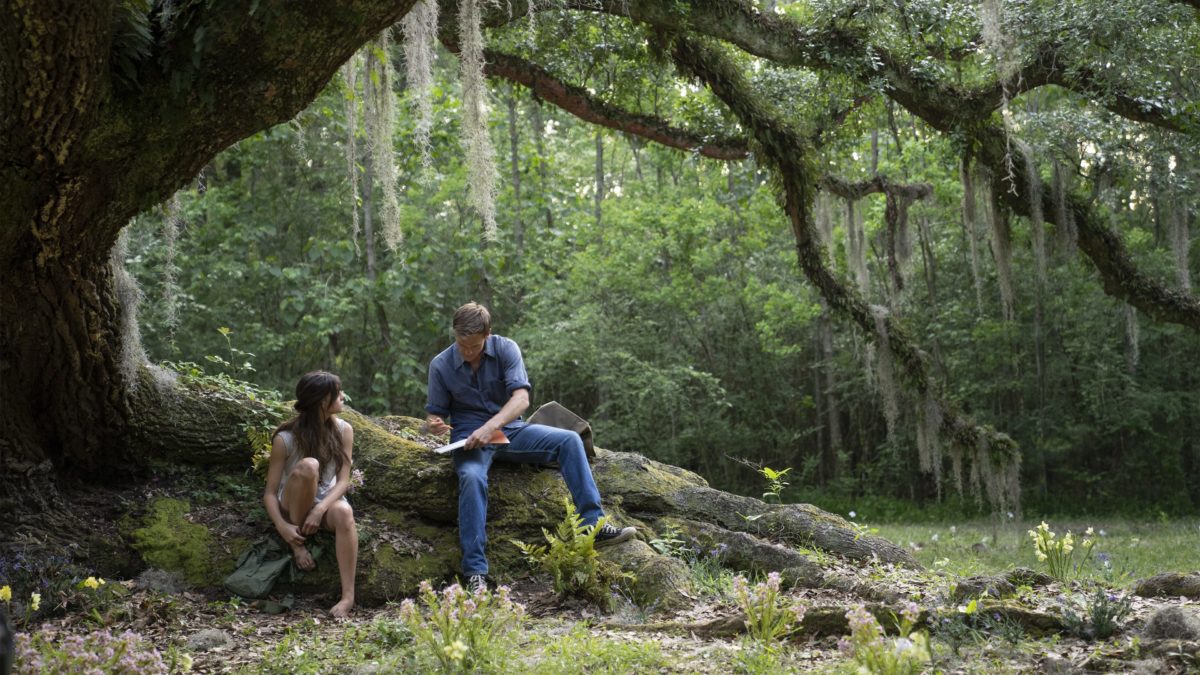The title of “Where the Crawdads Sing” suggests that the central concept of the story is its setting. I think the best version of this film would better reflect that idea: A piece of cinema whose main purpose is to capture the power, darkness, beauty, and/or majesty of the unique biome that is the marshes of North Carolina (though actually shot in Louisiana). The narrative, after all, is already somewhat of a reaction to the murky, existential gloom of the marshland.
Indeed, the handful of moments in the movie that exist solely to intoxicate us with nature are excellent and well-shot: flora with both faded and bold colors; a curious array of animals. A space both haunted and vibrant.
Alas, Where the Crawdads Sing isn’t patient or restrained enough to capture a boggy mood. It is, instead, a sloppy and fussy adaptation, too devoted to capturing all the beats of its source material to ever properly develop into a piece of cinema that stands on its own. The script is hackneyed and too busy, completely absent the moody tension that the swamps beg for and that made the book a hit in the first place.

The film tells the story of Kya (Daisy Edgar-Jones), an abandoned child who grows up deep in the marshes, surviving mostly in self-sustaining isolation. We follow her across two timelines — one starting when she’s a young child and through her youth and adolescence, the second at a murder trial where she is the defendant as young adult in 1969, with the plots converging in the final act.
Kya, who lives in a shack without electricity in the swamp, captures her own food, and affords basic supplies by selling mussels she collects. She is a naturalist, always learning about plants and animals, constantly drawing them in her sketch book. As she grows up, she gradually connects with some people in a nearby town — a black couple who sell boating supplies at an outpost, and eventually two boys: the generous, observant Tate (Taylor John Smith) and local hotshot Chase Andrews (Harris Dickinson) — the latter of whom, we know, Kya is eventually accused of murdering.
Thus, Where the Crawdads Sing is in the lineage of both Gone Girl-style thrillers, full of dark revelations and unreliable narrators, and teen romantic dramas, with a love triangle between two boys with very different personalities. It’s not a bad idea in concept, especially when married with the intriguing premise and setting of Kya’s background.
But the screenwriter (Lucy Alibar adapting Delia Owens’ novel) and the director (Olivia Newman) don’t quite have the vision to gel it all together. For one, they’re overly committed to telling Kya’s life story; the whole first act deals with Kya’s family troubles as a kid, dragging out the opening with little vignettes that have little bearing on the rest of the film.
Worse, there’s no management of tone in the story. The flavor and tension of scenes often turns on a dime. The movie has no idea what to do with the courtroom scenes, which present abrupt shifts from the pastoral of Kya’s life — and not in any sort of bracing, juxtaposed way. David Straithairn appears as a kindly lawyer who becomes the movie’s most important character in the film’s climax. His performance is good (the best in the movie, in fact), but he’s an emblem of the story’s confusion of its narrative objectives: mystery, romance, thriller, or all of the above?
The ending on the murder mystery front, in particular, falls into an unsatisfying middle ground of storytelling ambivalence. It’s neither a kick-in-the-teeth twist, nor satisfyingly ambiguous; just a frustrating shrug.
I also hope you like cliches, because the movie is absolutely drowning in them. I’d read the book prior to watching the movie, but even if I hadn’t, I think I would have guessed 90% of the plot points at least a few scenes in advance. So much of the dialogue is boilerplate. You better believe, e.g., that the nice boy Tate will tell Kya “it’s not your fault” when she breaks down crying about her missing abusive father.
The worst victims of the cliche avalanche are Jumpin’ and Mabel (Sterling Macer, Jr. And Michael Hyatt), the supportive black couple who mentor Kya. Having a trite love triangle is one thing; but having the lone characters of color come across as caricatures is problematic, especially when the script occasionally highlights the theme of elevating the marginalized. Apparently the writers see this as an issue for its white protagonists only.

The film holds together in a technical sense. The score by Mychael Danna is a bit overbearing but otherwise fine at capturing the swamp spirit with some banjo plucking. The movie is always fairly attractive visually, especially exterior shots. And there’s really solid period details throughout.
Edgar-Jones is quite watchable as Kya, providing sufficient interiority and cohesion to a character who is written in a bunch of different directions. On the other hand, she never evokes someone who really grew up out of civilization. The acting, in general, is fairly solid, with an obvious weak link in Dickinson, who can’t decide how slimy to play Chase; the moments where he breaks bad are neither a natural part of his arc nor jarring shifts, resulting in a a weirdly bland character.
The sum of it all is a film that isn’t bad in any aggressive or interesting way so much as it is misguided and a bit forgettable.
- Review Series: 2022: Year in Film
Is It Good?
Not Very Good (3/8)
Dan is the founder and head critic of The Goods. Follow Dan on Letterboxd. Join the Discord for updates and discussion.

